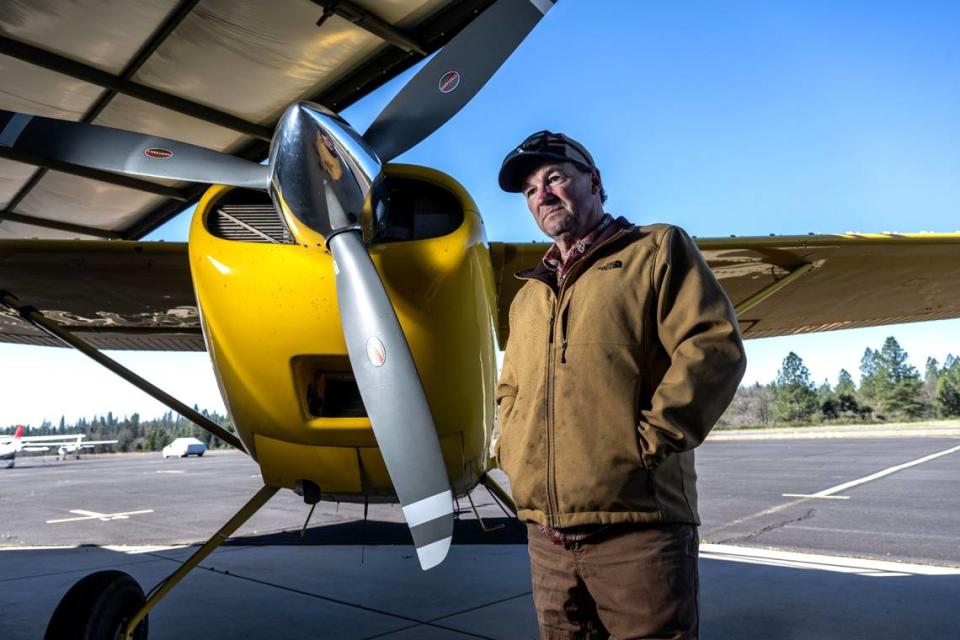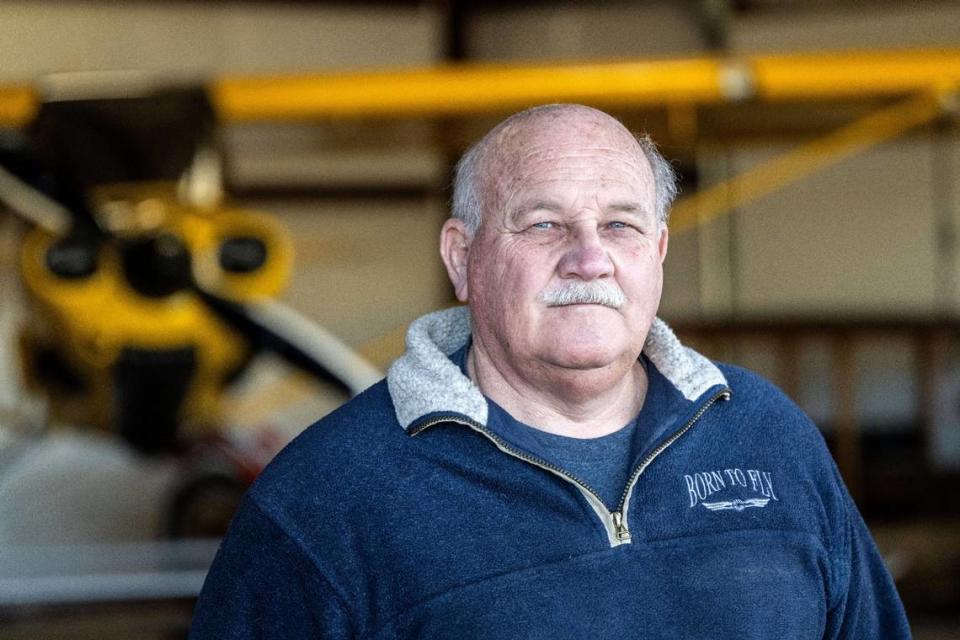At small California airport where tall pine trees loom, grand jury sees ‘potential death trap’
At a small Northern California airport managed by a county department’s division of “airports and cemeteries,” a withering grand jury report found that pilots fly in terror of the very tall pine trees that stand uncomfortably close to the runways.
Multiple pilots have clipped these pine trees, the El Dorado County grand jury said in a February report. One pilot took off from Georgetown and, when he landed in Cameron Park, discovered he had decapitated a conifer: A two-foot portion of tree top was stuck to the undercarriage of his plane.
“They’re really lucky that they weren’t slightly lower and got a bigger section of the tree,” Scott Herring, a pilot based at Georgetown Airport since 1997, told The Sacramento Bee in an interview.
The report says the pines make landing, in particular, even more dangerous.
“To knowledgeable pilots operating under ideal weather conditions, the airport is rapidly becoming unusable,” the report said. “To pilots without local knowledge operating under less-than-ideal weather or night conditions, it’s a potential death trap.”
Caltrans suspended night operations last December at the public, two-runway airport roughly 10 miles north of Placerville, which is managed by the El Dorado County Planning and Building Department. The grand jury report said “hundreds of small planes” use the airport each year.
A spokesperson for El Dorado County, Carla Hass, did not answer questions about the findings. She said staff were working on a formal response that would be presented to the Board of Supervisors by May 20, the required 90-day deadline for county officials to answer the grand jury.
But the grand jury report said the county has been “working on addressing the issue for two years, without any tangible progress.”
The report also contends that the county “has been aware of these unsafe airport conditions since at least 2013 when it received a service request to remove overgrown trees,” and that the airport is not in compliance with Federal Aviation Administration or state regulations.
“For at least 10 years, we’ve been bringing up this problem that these trees on the south end are getting taller and taller,” said Herring, who has more than 6,000 hours of recorded flight time. “They’re getting into the point where you have to make an adjustment to your flight path to get over them. And that’s difficult for students when they’re learning.”

The county operates its two airports at a loss of about $500,000 a year from the general fund. Last year, the Board of Supervisors funded a $50,000 “economic development plan” for the facilities in Georgetown and Placerville.
The grand jury asked, “Could that $50,000 have been better spent on ensuring the airport is safe much earlier?”
Axing the offending trees may cost the county more than the economic development plan. The report says that engineers believe there are more than 1,500 trees across 6 to 8 acres that need to be removed. The project, it was estimated, will run between $50,000 to $100,000.
The county Board of Supervisors placed an item on the consent agenda of Tuesday’s meeting to transfer $50,000 from the general fund to Georgetown Airport. The item also includes a form for submission to Cal Fire that would clear the way to remove about 3 acres of the troublesome trees.
In the interim, the grand jury said, there’s a risk that those trees might kill someone.
And the grand jury report suggested that perhaps the division that manages cemeteries is not the best fit to manage airports, calling the marriage “a particularly awkward fit.”

Flight risk
Pilots carped repeatedly about the trees. The grand jury quoted two pilots’ statements from a November 2023 Airport Advisory Committee meeting, where attendees were responding to the news that that the tree cull would take two years.
“I’ve been here for 25 years, and the trees have been talked about a lot, but now the trees are an endangerment to the pilots and to the houses near there,” one said. “You cannot see these trees when you are starting to slow the plane down to get down to what is called the ‘over the fence’ speed. I think I might have hit one the other day and I have flown into Georgetown probably more than anyone else in the history of the airport. I have 4000+ hours of flight time around Georgetown and the trees are really tall. I think the rain this year did this.
“We can’t wait two years.”
A second pilot quoted in the report agreed that the changes could not wait. “I actually stopped flying my plane into Georgetown because I believe I clipped the trees on my last takeoff,” the flier said, “and it is forking terrifying.”
The pilot continued, “We have to do something, because someone’s going to die and then we’re really going to regret not doing something.”
Gary Vorderbruggen, a pilot and Georgetown resident, said he has been involved with the advisory committee for about 15 years. He said the operation over the last four or five years has been in “shambles.”
“Something needs to be done and the county won’t get off their rear ends and do anything.”

The grand jury in its report said: “General aviation airports don’t get a lot of political attention because they benefit so few constituents and are only politically relevant as a revenue generator and/or emergency preparedness resource.”
In addition to benefiting very few constituents, the report pointed out, Georgetown bleeds money out of the county’s general fund: “There is an understandable reluctance,” it said, “to invest a significant additional operating cost in a money-losing venture.”
But still, the investigation found, those trees are a menace.
Herring described the worst-case scenario: a tree ripping off a wing or tail of a plane, sending the aircraft spiraling into a nearby home.
“If the trees were gone, it would be just a much safer environment for everyone,” he said.
An evergreen problem
The February report said that the county “showed a general lack of urgency for the situation until the Grand Jury began investigating the issue.”
An enforcement action from Caltrans, the report said, also seemed to spur public officials.
In a letter dated March 19, 2022, an aviation safety officer with Caltrans wrote to the Georgetown Airport manager demanding that the county submit “a detailed obstruction reduction plan by July 30, 2022.” The officer, Christopher Brooks, threatened to suspend night operations if such a plan were not produced.
A year and 10 months later, Brooks sent another letter, dated Dec. 7, 2023. “We recognize your efforts toward future obstruction clearing, however, the risk to persons and property requires Caltrans Aeronautics Programs to initiate airport permit action.”
The letter suspended nighttime operations at the airport until Caltrans determined that problems laid out in the March 19, 2022, letter “no longer exist.”
A week later, the airport produced an interim safety plan. Instead of taking two years, the county estimated that the problem could be solved by the end of 2024. Three acres of the most troubling trees are first on the schedule for the chopping block.
The Bee’s Hector Amezcua contributed to this story.

